
Did you know that emus, the large flightless birds native to Australia, require specific conditions and care in order to thrive?
Building an Emu Sanctuary is a complex endeavor that involves various requirements and guidelines to ensure the well-being of these unique creatures. From selecting the ideal location to designing suitable habitats and implementing safety measures, every aspect must be carefully considered.
In this discussion, we will explore the essential requirements and guidelines for creating an Emu Sanctuary, providing you with valuable insights and practical advice that will set you on the path to success.
Key Takeaways
- Location and legal requirements are crucial when building an emu sanctuary, including considering climate, land availability, zoning restrictions, and necessary permits.
- Habitat design and maintenance should prioritize providing enough space for emus to move comfortably, incorporating suitable vegetation, and creating different zones for various activities.
- Fencing and enclosure specifications should use durable materials, have a minimum height of 6 feet, and be regularly inspected and repaired to maintain security.
- Emu breeding and management require selecting healthy emus, providing suitable nesting areas, and implementing effective strategies for successful reproduction.
Location Selection
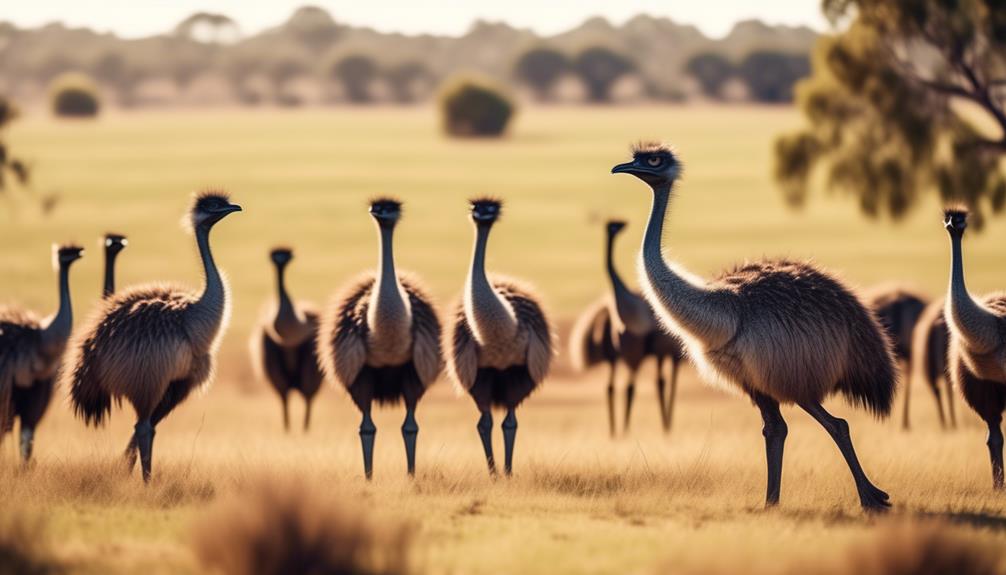
When selecting a location for an Emu Sanctuary, it's important to consider various factors to ensure the well-being and safety of the emus. Two critical aspects to evaluate are climate considerations and land availability.
First, climate considerations are essential for the health and comfort of the emus. Emus thrive in temperate climates with moderate temperatures. They're sensitive to extreme heat or cold, which can negatively impact their overall well-being. Therefore, it's important to choose a location that offers a suitable climate year-round, with adequate shade and protection from harsh weather conditions.
Second, land availability is crucial for creating a spacious and secure environment for the emus. Emus require ample room to roam and exhibit their natural behaviors. Look for a location that provides sufficient land area to accommodate their needs, including grazing areas, nesting sites, and potential expansion in the future. Additionally, ensure the land is securely fenced to prevent escape and protect the emus from predators.
Legal and Zoning Requirements
To ensure the successful establishment of an Emu Sanctuary, it is essential to understand the legal and zoning requirements that must be met. These requirements vary depending on the location and jurisdiction, but there are some common considerations to keep in mind.
One of the first steps is to research the zoning restrictions in your area. Zoning regulations dictate how land can be used, and it's important to ensure that an Emu Sanctuary is a permitted land use in the designated zone. Some areas may have specific agricultural or conservation zones where the sanctuary can be located, while others may require a special permit or variance.
In addition to zoning restrictions, obtaining the necessary legal permits is crucial. This may include permits for land use, animal welfare, and environmental regulations. Working with local authorities and agencies will help you navigate the permit application process and ensure compliance with all relevant laws.
To help you better understand the legal and zoning requirements for establishing an Emu Sanctuary, refer to the table below:
| Legal and Zoning Requirements | Description |
|---|---|
| Zoning Restrictions | Research the designated zone and ensure that an Emu Sanctuary is a permitted land use. |
| Legal Permits | Obtain necessary permits for land use, animal welfare, and environmental regulations. |
Habitat Design and Layout
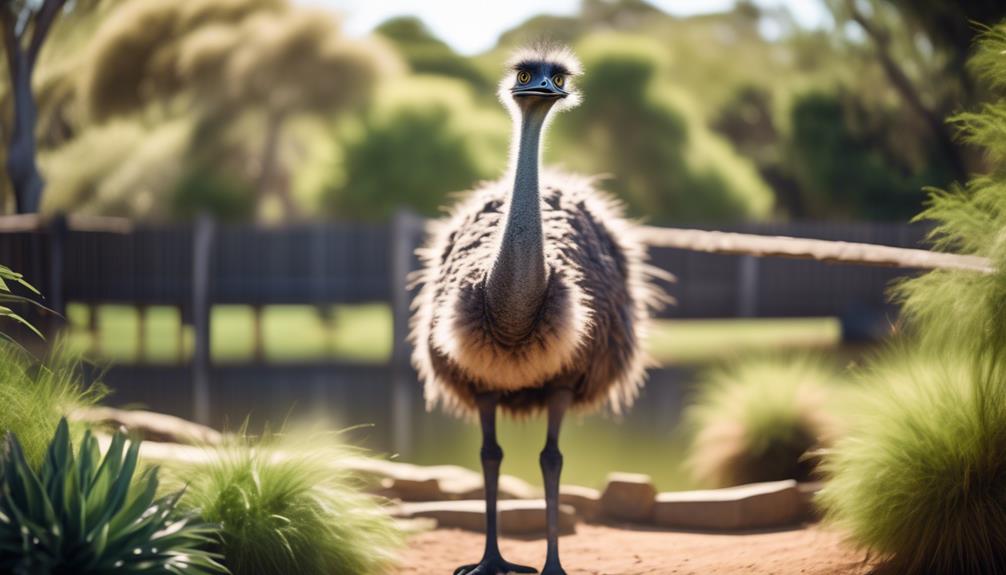
Have you considered how to design and layout the habitat for your Emu Sanctuary? To create a suitable environment for emus, it's essential to understand their behavior and socialization. Emus are social birds that thrive in groups, so it's recommended to have at least two emus in your sanctuary. When designing the habitat, ensure it provides enough space for the emus to move around comfortably and engage in natural behaviors.
Vegetation and landscaping choices play a crucial role in emu habitats. Emus are herbivores and require a diet rich in plant matter. Incorporating a variety of vegetation such as grasses, shrubs, and trees will provide the emus with the necessary food sources and create a more natural environment. Additionally, consider planting native species that are suitable for the local climate and can withstand the emus' browsing behavior.
When designing the layout, create different zones within the habitat to cater to the emus' needs. Include areas for feeding, resting, and nesting. Emus also enjoy dust bathing, so providing a designated area for this activity is important.
Remember to regularly assess and maintain the habitat to ensure the emus' well-being. By carefully considering emu behavior and socialization, as well as vegetation and landscaping choices, you can create a sanctuary that promotes their natural instincts and provides a comfortable and enriching environment.
Fencing and Enclosure Specifications
Emu sanctuaries require well-constructed fencing and enclosures to ensure the safety and containment of the birds. The following are some important guidelines to consider when designing and constructing fences and enclosures for your emu sanctuary:
- Fencing Materials: Select durable and sturdy materials that can withstand the emus' strength and potential weather conditions. High-tensile electric fencing or chain-link fencing with a minimum height of 6 feet is recommended to prevent emus from jumping over or escaping. Avoid using barbed wire as it can cause injury to the birds.
- Construction Techniques: Ensure that the fencing is securely installed by burying the bottom of the fence at least 1 foot in the ground to prevent emus from digging under it. Regularly inspect fences for any signs of wear or damage and promptly repair or replace any compromised sections. Install gates with strong latches to allow access for caretakers while maintaining the security of the enclosure.
- Additional Considerations: Emus are curious animals and may try to reach through or stick their heads between the fence openings. Use smaller mesh sizes or add electric wires along the fence to prevent them from doing so. Avoid using toxic or harmful materials in the construction of the enclosure to ensure the well-being of the emus.
Feeding and Nutrition Guidelines
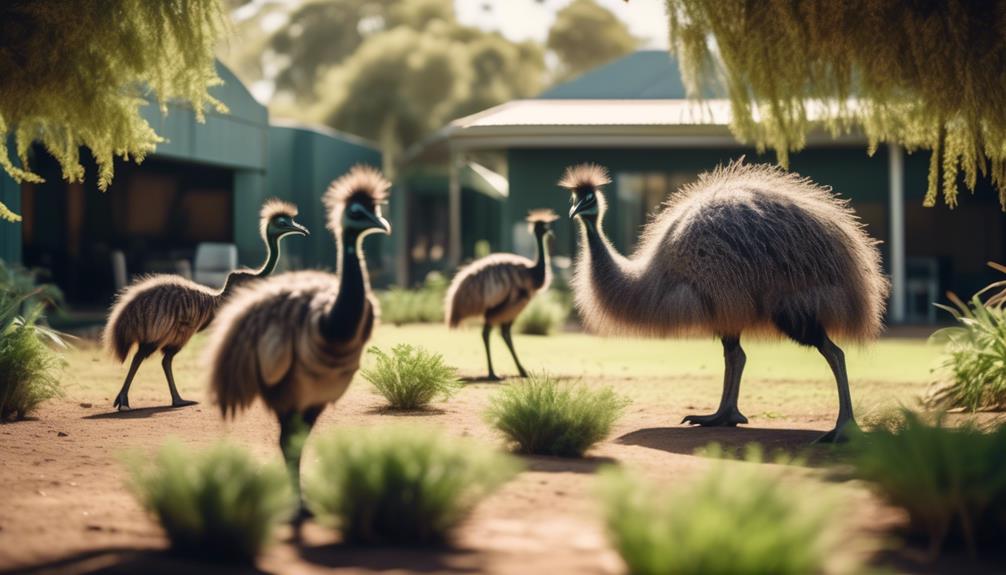
As you move on from ensuring the safety and containment of the emus through proper fencing and enclosure specifications, it's crucial to understand the feeding and nutrition guidelines for these remarkable birds. Providing a balanced and appropriate diet is essential to their health and well-being.
When it comes to the emu diet, it's important to mimic their natural feeding habits as closely as possible. Emus are omnivores, so their diet consists of both plant matter and small insects or animals. A balanced emu diet should include a variety of fruits, vegetables, grains, and protein sources such as insects, worms, and small rodents.
Establishing a feeding schedule is also crucial to maintain a healthy emu population. Emus should be fed twice a day, once in the morning and once in the evening. The amount of food provided should be based on their age, size, and activity level. It's important to monitor their food intake to prevent overfeeding or underfeeding.
Emu Breeding and Management Practices
To effectively manage and breed emus, it's essential to implement proper breeding and management practices. Here are some key techniques and management strategies for successful emu reproduction:
- Breeding Pair Selection: Choose healthy emus with good genetics for breeding. Consider factors such as age, size, temperament, and fertility when selecting breeding pairs.
- Nesting and Incubation: Provide suitable nesting areas for emus, consisting of soft soil or sand. Emus lay large green eggs, and the male is responsible for incubating them. Ensure the male has access to a secure nesting area and provide proper temperature and humidity levels for successful incubation.
- Chick Rearing: Once the eggs hatch, emu chicks require proper care and nutrition. Provide a safe and clean brooding area with adequate heating and ventilation. Feed the chicks a balanced diet of commercial emu starter feed, supplemented with fresh greens and insects.
Veterinary Care and Health Monitoring

After ensuring the successful breeding and management of emus, it's imperative to prioritize veterinary care and health monitoring to maintain the well-being of these magnificent birds. Emus, like any other animals, require regular veterinary check-ups and preventive care to ensure they stay healthy. As the caretaker of an emu sanctuary, it's crucial to have proper veterinary training or consult with a qualified veterinarian who's experience with exotic birds.
Regular veterinary check-ups allow for early detection of any potential health issues and ensure timely intervention. This includes regular physical examinations, monitoring of vital signs, and laboratory tests as needed. Additionally, the veterinarian can provide guidance on proper nutrition, vaccinations, and parasite control to prevent diseases.
In addition to regular check-ups, it's essential to establish a comprehensive health monitoring system. This involves keeping detailed records of each emu's health history, including vaccinations, treatments, and any observed symptoms. Monitoring the emus' behavior, appetite, and droppings on a daily basis can help identify any changes that may indicate illness or distress.
To maintain optimal health and prevent the spread of diseases, it's crucial to implement strict biosecurity measures. This includes proper quarantine procedures for new arrivals, regular disinfection of enclosures, and limited visitor access to minimize the risk of introducing pathogens.
Environmental Enrichment Strategies
Implementing effective environmental enrichment strategies is essential for promoting the well-being and psychological health of emus in a sanctuary setting. Providing enrichment activities and behavioral stimulation can help alleviate boredom and prevent negative behaviors.
Here are three key strategies to consider:
- Structural Enrichment: Create a stimulating environment by incorporating various structures within the emu enclosure. This can include perches, platforms, logs, and tunnels for the emus to explore and interact with. These structures should be sturdy and safe to prevent any injuries.
- Foraging Opportunities: Emus are natural foragers, so providing opportunities for them to search for food can be highly beneficial. Scatter food throughout the enclosure or hide it in puzzle feeders to encourage the emus to engage in natural foraging behaviors. This will keep them mentally stimulated and physically active.
- Social Interaction: Emus are social animals and thrive in the presence of their own kind. Encourage social interaction by housing emus in groups whenever possible. This will provide them with companionship and opportunities for socialization, contributing to their overall well-being.
Safety Measures and Emergency Preparedness
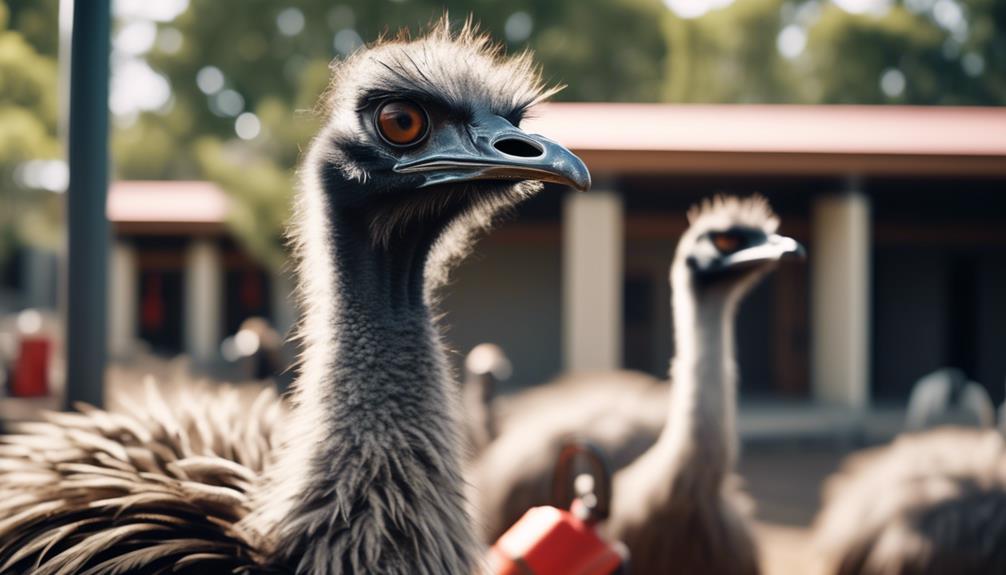
Ensuring the safety and preparedness of an emu sanctuary requires implementing effective measures and protocols. To minimize the risk of accidents and emergencies, conducting regular emergency drills is essential. These drills allow staff members to practice their emergency response skills and familiarize themselves with evacuation procedures. By simulating various scenarios, such as a fire or severe weather, staff can identify any weaknesses in their emergency plans and make necessary improvements.
In addition to emergency drills, having comprehensive first aid procedures is crucial for addressing any injuries or illnesses that may occur within the sanctuary. It's recommended that all staff members receive proper first aid training to effectively respond to emergencies. This includes knowing how to administer basic medical care, such as performing CPR, controlling bleeding, and stabilizing fractures. Maintaining a well-stocked first aid kit with essential supplies is also essential.
Furthermore, it's important to regularly review and update safety protocols to ensure they align with industry standards and best practices. This includes conducting risk assessments, identifying potential hazards, and implementing appropriate safety measures to mitigate those risks.
Visitor Guidelines and Educational Programs
To ensure a positive and educational experience for visitors, it's important to establish clear guidelines and offer engaging educational programs at the emu sanctuary. By adhering to these guidelines, visitors can actively participate in the conservation efforts and gain a deeper understanding of these magnificent birds.
Here are three key elements to consider when developing visitor guidelines and educational programs at the emu sanctuary:
- Visitor Engagement:
Encourage visitors to interact with the emus in a respectful and responsible manner. Provide opportunities for them to observe the emus in their natural habitat and learn about their behavior and habitat requirements.
- Conservation Awareness:
Educate visitors about the importance of emu conservation and the challenges they face in the wild. Highlight the sanctuary's role in protecting and preserving these unique birds and showcase the ongoing conservation efforts.
- Educational Programs:
Offer a range of educational programs tailored to different age groups and interests. These programs can include guided tours, interactive exhibits, and workshops that delve into various aspects of emu biology, behavior, and conservation.
Staffing and Training Considerations
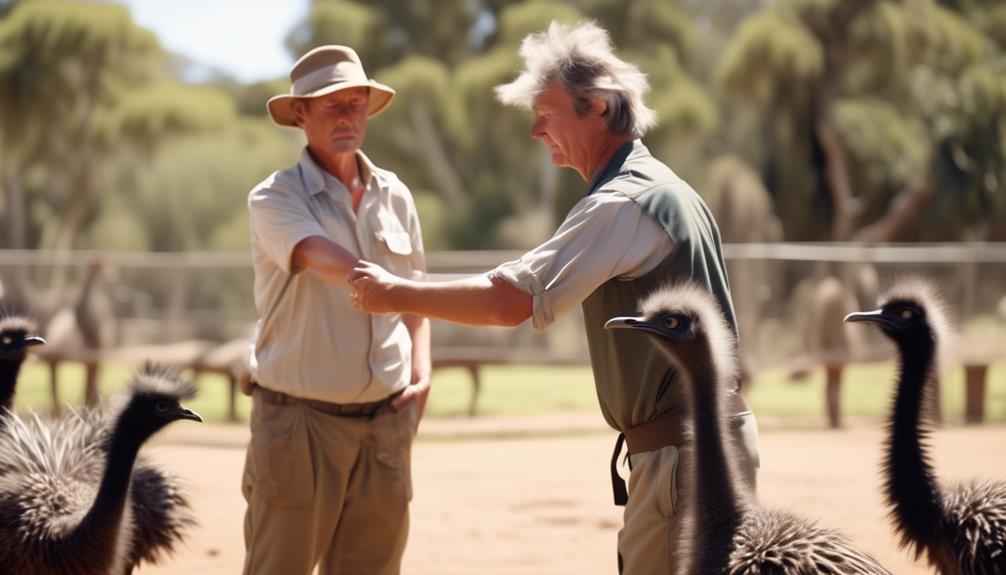
Consider the staffing and training needs to ensure the efficient operation and maintenance of the emu sanctuary. Staffing requirements for an emu sanctuary will vary depending on the size and scope of the facility. It's important to have a dedicated team of staff members who are knowledgeable about emus and their care.
Staff training is crucial to ensure that all employees have the necessary skills and knowledge to properly handle and care for the emus. Training should cover topics such as emu behavior, feeding and nutrition, enclosure maintenance, and emergency procedures. It's also important to provide ongoing training to keep staff members up to date with the latest research and best practices in emu care.
When hiring staff for the emu sanctuary, it's important to look for individuals who've experience working with animals, particularly birds. They should have a genuine passion for emus and a commitment to their welfare. Strong communication and teamwork skills are also essential, as staff members will need to work closely together to ensure the smooth operation of the sanctuary.
Sustainability and Funding Options
What are some sustainable funding options for an emu sanctuary?
When it comes to ensuring the long-term sustainability of an emu sanctuary, it's crucial to have effective fundraising strategies in place. Here are three sustainable funding options to consider:
- Donations and Sponsorships: Seek out individuals, organizations, and businesses that share a passion for wildlife conservation and are willing to donate or sponsor the sanctuary. Offer different levels of sponsorship with corresponding benefits, such as recognition on the sanctuary's website or signage at the facility.
- Grant Funding: Research and apply for grants specifically designed to support wildlife sanctuaries and conservation efforts. Look into both government and private foundation grants that align with the sanctuary's mission and goals.
- Community Engagement: Engage with the local community to build support and raise funds for the sanctuary. Host fundraising events, such as charity runs or educational workshops, and encourage community members to become regular donors or volunteers. By establishing strong relationships with the community, the sanctuary can foster a sense of ownership and create a sustainable network of support.
Frequently Asked Questions
What Are the Natural Predators of Emus and How Can We Protect Them From These Threats?
To protect emus from natural predators, you need effective strategies. Understand their threats and implement measures like fencing, habitat management, and predator deterrents. Emu sanctuary management requires careful mitigation of these challenges for their safety.
How Do Emus Communicate With Each Other and What Are Some Common Behaviors to Look Out For?
Emus communicate through a range of vocalizations, such as booming and grunting, as well as non-verbal cues like head movements. They exhibit behaviors like territorial displays and communal nesting, which are fascinating to observe in an emu sanctuary.
Are There Any Specific Regulations or Guidelines in Place for the Transportation of Emus to the Sanctuary?
Yes, there are specific regulations and safety guidelines in place for the transportation of emus to the sanctuary. These guidelines ensure the safe and humane transport of the birds, prioritizing their well-being throughout the journey.
Can Emus Coexist With Other Animal Species in the Sanctuary, and if So, What Precautions Should Be Taken?
Emus can coexist with other species in the sanctuary, but precautions are necessary. Monitor interactions to prevent aggression or harm. Provide separate spaces for different animals to minimize conflicts. Safety is key for harmonious coexistence.
What Are the Potential Risks or Challenges Associated With Managing and Maintaining an Emu Sanctuary, and How Can They Be Mitigated?
Managing and maintaining an emu sanctuary involves potential risks and maintenance challenges. To mitigate these, focus on effective risk management strategies and stay proactive in addressing any potential issues that may arise.
Conclusion
So there you have it, mate! Building an emu sanctuary requires careful consideration of several factors.
One of the first things to think about is the location. You'll want to find a place that is suitable for emus to thrive, with enough land and suitable habitat.
Next, it's important to understand the legal requirements involved in establishing a sanctuary. You'll need to research and comply with any regulations or permits necessary for housing and caring for emus.
Habitat design is another crucial aspect. You'll want to create an environment that mimics the natural conditions emus are accustomed to. This includes providing them with ample space to roam and ensuring they have access to appropriate shelter and nesting areas.
Fencing is also essential to keep the emus safe and secure. Emus are strong and can jump high, so you'll need to invest in sturdy and tall fencing that can withstand their attempts to escape.
Feeding guidelines are important to ensure that the emus receive a balanced and nutritious diet. Research their dietary needs and plan accordingly, whether it involves providing natural forage or supplementing their diet with commercial feed.
Safety measures are crucial for both the emus and any visitors to the sanctuary. This may include implementing protocols to prevent disease transmission and ensuring that there are no potential hazards in the emus' environment.
Visitor guidelines are necessary to ensure the well-being of the emus and the safety of the visitors. Establish rules and regulations for visitors, such as no feeding or touching the emus, to protect both parties.
Staffing is another consideration. Depending on the size of the sanctuary, you may need a team of dedicated staff members to care for the emus, maintain the facilities, and manage visitor interactions.
Lastly, funding options need to be explored to support the establishment and maintenance of the sanctuary. This may involve seeking grants, donations, or other sources of financial support.
It may seem like a tall order, but with the right planning and resources, you can create a safe haven for these magnificent creatures. Remember, 'no worries' – the emus will thank you for it!





